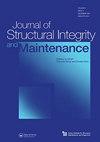Behavior and design of multi-sided composite sections
IF 3.1
Q2 ENGINEERING, CIVIL
Journal of Structural Integrity and Maintenance
Pub Date : 2023-10-16
DOI:10.1080/24705314.2023.2267329
引用次数: 0
Abstract
ABSTRACTComposite construction is advantageous due to the combination of steel and concrete materials in structural members. Composite column’s cross-section types such as hexagonal, octagonal, and decagonal and high diameter-to-thickness (D/t) ratios are highly desirable in transmission towers, yet not covered in the applicable codes. Therefore, the objective of this study is to investigate the behavior of composite columns with various characteristics including cross-section types, and height and propose a design procedure based on Force – Moment (P-M) Interaction diagrams and related equations. Three-dimensional non-linear finite element models were developed using a nonlinear finite element software to simulate and verify the behavior of the composite towers against prior experimental work. Concrete Damage Plasticity and Steel Bilinear Elasto-Plastic Model were calibrated and used in capturing the realistic nonlinear behavior of the materials and their interaction. Based on the computational models, a concrete reduction factor, needed for the development of design equations, was derived. Conclusively, typical normalized P-M Interaction diagrams were constructed for various polygonal shapes with high D/t ratios beyond code limitations. The corresponding derived design equations play a significant role in the applicability of the composite columns in transmission towers.KEYWORDS: Compositeconcrete damage plasticitynonlinear analysistransmission towersP-M diagrams List of symbols used in the manuscript Symbol=Descriptionγ=concrete strength reduction factorE=Modulus of Elasticityν=Poisson’s ratiof’c=Concrete Compressive Strengthɛ=Strainσ=StressKc=Shape of the yield surfacefbo=Initial biaxial compressive yield stressfco=Initial uniaxial compressive yield stressr=Total section radiusrc=Concrete section radiusd=Outer depth of the sectiondc=Inner depth of the sectiont=Steel section thicknessAs=Steel section areaFy=Yield stressZ=Section modulush=Distance from top of the section to depthDisclosure statementNo potential conflict of interest was reported by the author(s).多层复合截面的性能与设计
摘要组合结构的优势在于构件中钢与混凝土材料的结合。复合柱的截面类型,如六角形、八角形和十角形,以及高直径/厚度(D/t)比在输电塔中是非常理想的,但在适用的规范中没有涵盖。因此,本研究的目的是研究具有不同截面类型和高度的组合柱的行为,并提出基于力-矩(P-M)相互作用图和相关方程的设计程序。利用非线性有限元软件建立了三维非线性有限元模型,模拟和验证了复合塔的行为与先前的实验工作。对混凝土损伤塑性和钢双线性弹塑性模型进行了标定,并用于捕捉材料的真实非线性行为及其相互作用。在此基础上,推导出设计方程所需的具体折减系数。最后,针对超出代码限制的高D/t比的各种多边形形状构建了典型的归一化P-M交互图。推导出的设计方程对组合柱在输电塔中的适用性具有重要意义。关键词:复合混凝土损伤塑性非线性分析透光塔sp - m图手稿中使用的符号列表符号=描述γ=混凝土强度折减系数=弹性模量ν=泊松比c=混凝土抗压强度=应变σ=应力skc =屈服面形状bo=初始双轴抗压屈服应力fco=初始单轴抗压屈服应力=总截面半径rc=混凝土截面半径=截面外深度dc=截面内深度=钢材截面厚度as =钢截面面积y=屈服应力z =截面模量=从截面顶部到深度的距离披露声明作者未报告潜在的利益冲突。
本文章由计算机程序翻译,如有差异,请以英文原文为准。
求助全文
约1分钟内获得全文
求助全文
来源期刊

Journal of Structural Integrity and Maintenance
ENGINEERING, CIVIL-
CiteScore
3.90
自引率
9.50%
发文量
24
 求助内容:
求助内容: 应助结果提醒方式:
应助结果提醒方式:


